TAXONOMY UPDATE COMPLETE
If you have eBirded any of the ‘splits’ listed below, click the [my records] links to confirm that your species are where you expect them to be. We update records automatically for you, but you can always use Change Species if you think something belongs to a different species. If you still see records appearing in unexpected ways please write to us.
Read on for more information about what’s changed. For a complete list of all taxonomic changes, check out the 2021 eBird Taxonomic Update page.
What’s happening?
Every day, new and fascinating discoveries are made by birders and ornithologists alike. Technological advances are helping us learn more about bird species around the world, from eBird reports of a species outside its known range to more complete understandings of genetic relationships among bird species. This month, we’re going through your more than 1,053,114,868 eBird observations and updating them to the most current ornithological knowledge. Taxonomy Day (as we like to call it at eBird) is a time to reflect on all that we have learned about birds throughout our lifetimes—and how much there still is to learn!
This year’s taxonomy update (v2021) includes 17 newly-described species, an increase of 94 new species from ‘splits’ of one species into two or more different species, and 8 ‘lumps’—birds that were formerly considered to be multiple species, but now are considered to be a single species. This results in an increase of 103 species to a global total of 10,824 species. There are also many changes to scientific names and taxonomic ordering of species based on their evolutionary relationships. Recognizing a species isn’t just about changing the name or adding a new lifer; full species status can have significant impacts for conservation or research as well.
Many times new species emerge after years of detective work, examining museum specimens, genetic data, and audio recordings. Other times well-known subspecies are separated after stronger data showing physical, genetic, and/or vocal differences become available. Your observations can be the spark that inspires ornithologists to examine taxonomic relationships among species. Maybe your media played a part in helping separate or lump species this year? Thank you for your eBird checklists and media contributions to the Macaulay Library—you help make this possible!
What do you need to do?
For the most part, you can sit back, keep eBirding, and check out your lists after the update is complete. This complex process may require a couple weeks before it is fully complete. We update all of your records automatically, so you don’t have to do anything to have your lists reflect the latest taxonomy. The best thing you can do is read on to learn more about the changes.
2021 eBird Taxonomy Update Changes
Below, we highlight the taxonomic changes that are most likely to affect your life list:
For a complete list of all taxonomic changes, check out the 2021 eBird Taxonomic Update page.
Plumage similarities and overlapping ranges can make species-level identification difficult. In situations where you’re unsure which species you observed, use caution. eBird provides ‘slash’ and ‘spuh’ options—including for many split and lumped species listed below—for conservative reporting whenever species identity is uncertain.
2021 New Species
Each year, a few newly described species or newly recognized populations are named and added to the eBird/Clements taxonomy. This year’s update was a banner year for newly-described species, thanks largely to seminal papers on Scytalopus tapaculos, the Rufous/Chestnut Antpitta complex, and reports on some taxonomic studies in Indonesia!
- Alor Myzomela Myzomela prawiradilagae [map] [media] [my records]
- Taliabu Myzomela Myzomela wahe [map] [media] [my records]
- Peleng Fantail Rhipidura habibiei [map] [media] [my records]
- Kilombero Cisticola Cisticola bakerorum [map] [media] [my records]
- White-tailed Cisticola Cisticola anderseni [map] [media] [my records]
- Ampay Tapaculo Scytalopus whitneyi [map] [media] [my records]
- Jalca Tapaculo Scytalopus frankeae [map] [media] [my records]
- White-winged Tapaculo Scytalopus krabbei [map] [media] [my records]
- Loja Tapaculo Scytalopus androstictus [map] [media] [my records]
- Taliabu Bush Warbler Locustella portenta [map] [media] [my records]
- Satin Berrypecker Melanocharis citreola [map] [media] [my records]
Plus six newly-described antpittas from within the Rufous Antpitta complex, each recognized as a species:
- Oxapampa Antpitta Grallaria centralis [map] [media] [my records]
- Ayacucho Antpitta Grallaria ayacuchensis [map] [media] [my records]
- Puno Antpitta Grallaria sinaensis [map] [media] [my records]
- Chami Antpitta Grallaria alvarezi [map] [media] [my records]
- Chachapoyas Antpitta Grallaria gravesi [map] [media] [my records]
- Panao Antpitta Grallaria oneilli [map] [media] [my records]
Meet the Satin Berrypecker
High in the mountains of western New Guinea, a team of ornithologists set out to explore a biologically underexplored region. There they encountered an unfamiliar species of berrypecker that looked different from others they had seen. Armed with curiosity, the team investigated the genetics of the berrypecker genus in New Guinea and examined the physical characteristics of the unknown species in relation to known species. After years of careful analysis the team discovered that the species is genetically and physically different from the other berrypeckers in New Guinea. It sports satin white underparts that are tinged in yellow unlike the other berrypeckers, which is how it got its name—the Satin Berrypecker.
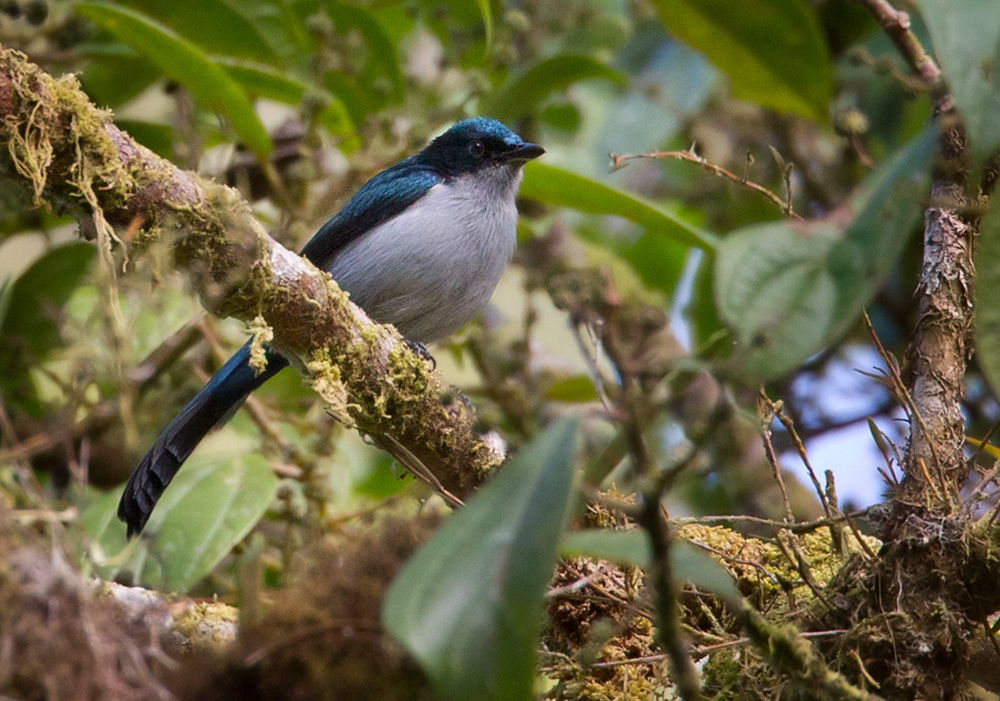
Recent genetic evidence suggests Fan-tailed Berrypecker (above) is a close relative of the newly described Satin Berrypecker Melanocharis citreola. Satin Berrypeckers are distinguished by a lemony-yellow tinge to their underparts. Fan-tailed Berrypecker © Lars Petersson / Macaulay Library
Two undescribed cisticolas finally get official names
An international team of ornithologists formally named two undescribed cisticola warblers in southwestern Tanzania. The team examined physical and genetic differences with museum specimens and voice recordings collected during field expeditions as well as recordings archived in the Macaulay Library and xeno-canto.
Genetic, vocal, and plumage differences, the authors suggest, warrant formal description of the two species: the Kilombero Cisticola and the White-tailed Cisticola. The Kilombero Cisiticola belongs to the “plain-backed dueting” cisticolagroup while the White-tailed Cisticola belongs to the “streaked back marsh” group. Vocally, the two species have distinct calls and songs that separate them from other cisticolas. The Kilombero Cisticolas sings a three to five note song but unlike other cisticolas their song starts on a low pitch. White-tailed Cisticolas are more nasal sounding, similar to a squeaky toy, separating them from other cisticola species.
These new cisticolas are extremely range restricted and of high conservation concern, hence the authors recommend that these species be classified as globally endangered in hopes that the wetland complex where they occur can be protected. Be sure to check out Linda Macaulay’s audio recordings of these two species!
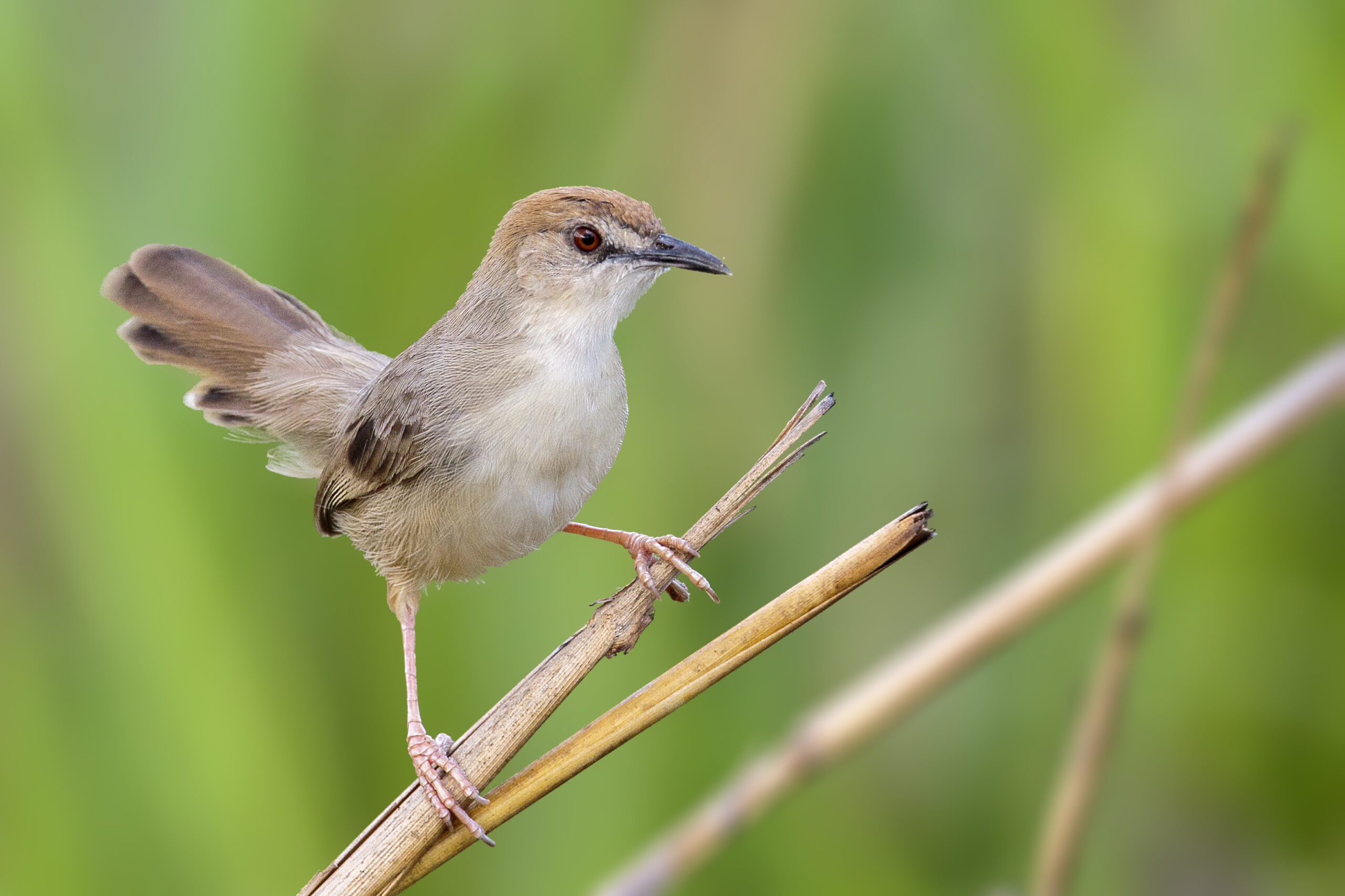
Two new cisticolas, including the Kilombero Cisticola (above), were described from the same wetland complex in Tanzania. These were previously recognized in eBird as undescribed species. Both are extremely range restricted and of high conservation concern. Kilombero Cisticola © Bradley Hacker / Macaulay Library
2021 ‘Splits’
Variable Chachalaca Ortalis motmot is split into:
- Variable Chachalaca Ortalis motmot [map] [media] [my records]
- Chestnut-headed Chachalaca Ortalis ruficeps [map] [media] [my records]
The two species are divided by the Amazon River, Variable to the north (to the Guianas) and Chestnut-headed, a Brazilian endemic, to the south of the river.
Dusky-legged Guan Penelope obscura is split into:
- Dusky-legged Guan Penelope obscura [map] [media] [my records]
- Yungas Guan Penelope bridgesi [map] [media] [my records]
The two species are similar, but have consistent plumage differences and are well separated by range, with Dusky-legged Guan in Brazil, Paraguay, and northern Argentina (e.g., Misiones), and Yungas Guan along the east slope of the Andes from central Bolivia to Catmarca, Argentina.
Crested Argus Rheinardia ocellata is split into:
- Vietnamese Crested Argus Rheinardia ocellata [map] [media] [my records]
- Malayan Crested Argus Rheinardia nigrescens [map] [media] [my records]
This split highlights how photos of birds in life and audio recordings can help supplement museum specimens for taxonomic assessments; it was additional information about soft parts colors (which fade), crest structure (best seen in live birds), and vocalizations that made the case for this split. Already considered Endangered before the split, Malayan Crested Argus is even rarer (very few eBird records) than Vietnamese Crested Argus and is immediately of elevated conservation concern now that its distinctiveness is fully recognized.
Vaux’s Swift Chaetura vauxi is split into:
- Vaux’s Swift Chaetura vauxi [map] [media] [my records]
- Ashy-tailed Swift Chaetura andrei [map] [media] [my records]
Swifts in the genus Chaetura are among the most enigmatic taxa of birds worldwide, since their plumage and structure are nearly identical between species. Even as Amazonian Swift is lumped (see below), a new swift species is recognized, with the localized and poorly-known Venezuela endemic Ashy-tailed Swift being granted species status, separated from Vaux’s Swift which is widespread in North and Middle America and already a challenge to separate from migrating Chimney Swifts.
African Palm-Swift Cypsiurus parvus is split into:
- African Palm-Swift Cypsiurus parvus [map] [media] [my records]
- Malagasy Palm-Swift Cypsiurus gracilis [map] [media] [my records]
Voice and plumage have indicated that the palm-swifts on Madagascar and Comoros are distinct from those on mainland Africa.
Festive Coquette Lophornis chalybeus is split into:
- Butterfly Coquette Lophornis verreauxii [map] [media] [my records]
- Festive Coquette Lophornis chalybeus [map] [media] [my records]
Differences in displays and iridescence of males is continuing to reveal that taxa formerly considered subspecies are in fact reproductively isolated. Festive Coquette occurs in the Atlantic Forests of southeast Brazil, while Butterfly Coquette is more widespread in northern and central South America.
Broad-billed Hummingbird Cynanthus latirostris is split into:
- Broad-billed Hummingbird Cynanthus latirostris [map] [media] [my records]
- Turquoise-crowned Hummingbird Cynanthus doubledayi [map] [media] [my records]
Turquoise-crowned Hummingbird has sometimes been known as Doubleday’s Hummingbird. Genetics seem to unequivocally support the split, and plumage is distinctive and consistent.
Gray-breasted Sabrewing Campylopterus largipennis is split into:
- Gray-breasted Sabrewing Campylopterus largipennis [map] [media] [my records]
- Diamantina Sabrewing Campylopterus diamantinensis [map] [media] [my records]
Following the 2019 recognition of Outcrop Sabrewing Campylopterus calcirupicola (formerly Dry-forest Sabrewing), another localized population is split: Diamantina Sabrewing, occurring in Serra Espinhaço in Minas Gerais, Brazil, is recognized as distinct from the still-widespread Gray-breasted Sabrewing.
Kentish Plover Charadrius alexandrinus is split into:
- Kentish Plover Charadrius alexandrinus [map] [media] [my records]
- White-faced Plover Charadrius dealbatus [map] [media] [my records]
The saga of the White-faced Plover in Southeast Asia has been a very interesting case, with unusually-plumaged birds first noticed on the wintering grounds in Thailand. In more recent years, the taxonomic affinities of these birds have been worked out, their breeding grounds have been identified, and their status as a unique species has been confirmed and now has broad agreement.

White-faced Plovers, like the one above, are distinguished from Kentish Plovers by their paler upperparts and white lores. White-faced Plover © Saravanan Krishnamurthy / Macaulay Library
South American Snipe (South American) Gallinago paraguaiae paraguaiae is split into:
- Paraguayan Snipe Gallinago paraguaiae [map] [media] [my records]
- Magellanic Snipe Gallinago magellanica [map] [media] [my records]
Similar in plumage, the two species differ in displays and vocalizations. Paraguayan Snipe occurs widely in South America and Magellanic Snipe are restricted to Argentina and Chile, but caution is warranted in migration and the austral winter when some Magellanic Snipe move north to winter at least rarely as far north and east as Uruguay.
Mew Gull Larus canus is split into:
- Common Gull Larus canus [map] [media] [my records]
- Short-billed Gull Larus brachyrhynchus [map] [media] [my records]
Birders who enjoy challenging gull ID can now try to find Common Gull (typically found in East Asia and Europe) in North America and Short-billed Gull (the North American species) in other regions. Check ‘Mew Gulls’ in the Eastern US and Canada with care, as both species may occur in that area.
Royal Tern Thalasseus maximus is split into:
- Royal Tern Thalasseus maximus [map] [media] [my records]
- West African Crested Tern Thalasseus albididorsalis [map] [media] [my records]
Although very similar in plumage and structure, genetic evidence suggests these two terns are not closely related. They don’t overlap in range, except as vagrants to western Europe where a new, extremely hard ID challenge is presented to keen birders who find out-of-range terns.
Eurasian Scops-Owl Otus scops is split into:
- Eurasian Scops-Owl Otus scops [map] [media] [my records]
- Cyprus Scops-Owl Otus cyprius [map] [media] [my records]
Cyprus Scops-Owl is a resident endemic on Cyprus, but identification can be tricky when migrant Eurasian Scops-Owls are passing through. Voice is the best way to separate the species.
Spotted Eagle-Owl Bubo africanus is split into:
- Arabian Eagle-Owl Bubo milesi [map] [media] [my records]
- Spotted Eagle-Owl Bubo africanus [map] [media] [my records]
Well-separated by range, Arabian Eagle-Owl (restricted to the Arabian Peninsula) and Spotted Eagle-Owl (of central and southern Africa) also differ in vocalizations, which helps define species limits in many species of nightbirds.
Collared Owlet Glaucidium brodiei is split into:
- Collared Owlet Taenioptynx brodiei [map] [media] [my records]
- Sunda Owlet Taenioptynx sylvaticus [map] [media] [my records]
Sunda Owlet, which differs from the widespread Collared Owlet in voice and plumage, is restricted to Sumatra and Borneo and does not overlap in range with its sister species.
Tawny Owl Strix aluco is split into:
- Tawny Owl Strix aluco [map] [media] [my records]
- Maghreb Owl Strix mauritanica [map] [media] [my records]
Maghreb Owl has a distinctive voice and is restricted to mountains of northern Africa.
Barred Owl Strix varia is split into:
- Barred Owl Strix varia [map] [media] [my records]
- Cinereous Owl Strix sartorii [map] [media] [my records]
These two species are similar in plumage, but are widely disjunct in range and have similar voices, as recently demonstrated by Spencer and Pieplow (2019). Cinereous Owl is only known from a few sites in Mexico, and additional locations should be actively explored; currently it is one of the rarest endemics in the country.
Southern Boobook Ninox boobook is split into:
- Southern Boobook Ninox boobook [map] [media] [my records]
- Rote Boobook Ninox rotiensis [map] [media] [my records]
- Timor Boobook Ninox fusca [map] [media] [my records]
- Alor Boobook Ninox plesseni [map] [media] [my records]
Rote, Timor, and Alor are all well-known for their high levels of endemism, which becomes even more pronounced as each has an endemic boobook that is now separated from the more widespread Southern Boobook of Australia, New Guinea, and some Indonesian islands east of Timor.
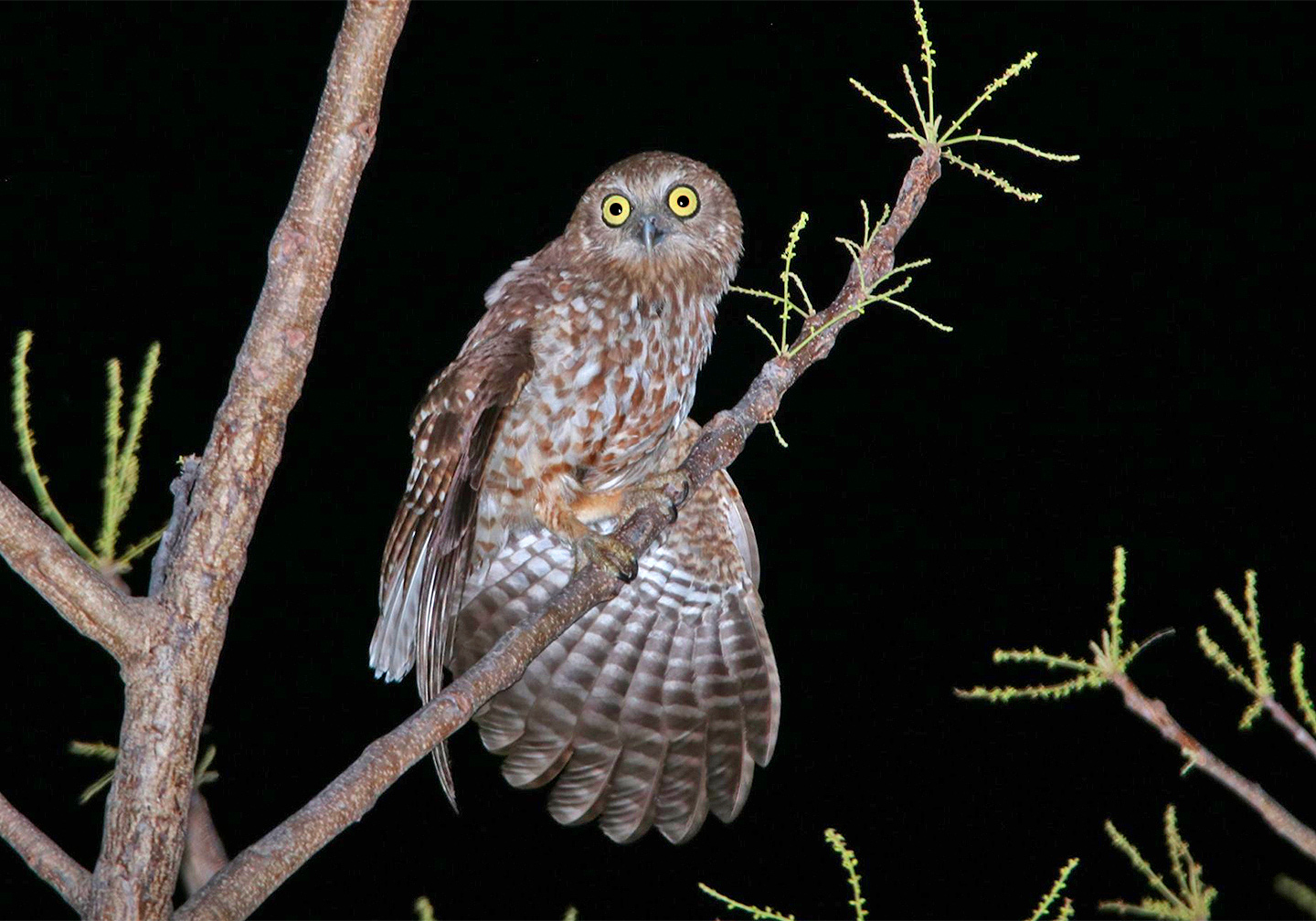
Rote Boobook © Tim Avery / Macaulay Library
Hantu Boobook Ninox squamipila is split into:
- Seram Boobook Ninox squamipila [map] [media] [my records]
- Buru Boobook Ninox hantu [map] [media] [my records]
Like many of the above owl splits, these two island endemics each have a distinctive voice.
Yellow-and-green Lorikeet Trichoglossus flavoviridis is split into:
- Yellow-cheeked Lorikeet Saudareos meyeri [map] [media] [my records]
- Sula Lorikeet Saudareos flavoviridis [map] [media] [my records]
Yellow-cheeked Lorikeet occurs on Sulawesi, while Sula Lorikeet is found on smaller islands (Taliabu, Seho and Mangole) to the east of Sulawesi. Note the genus change as well, as the nomenclature of these lorikeets and their relatives has been revised.
Blue-winged Parrotlet Forpus xanthopterygius is split into:
- Turquoise-winged Parrotlet Forpus spengeli [map] [media] [my records]
- Riparian Parrotlet Forpus crassirostris [map] [media] [my records]
- Cobalt-rumped Parrotlet Forpus xanthopterygius [map] [media] [my records]
Turquoise-winged Parrotlet adds yet another endemic to Colombia, while Riparian Parrotlet can be found in Amazonia and Cobalt-rumped Parrotlet can be found in tropical forests of southern South America.
Elegant Pitta Pitta elegans is split into:
- Ornate Pitta Pitta concinna [map] [media] [my records]
- Elegant Pitta Pitta elegans [map] [media] [my records]
- Banda Sea Pitta Pitta vigorsii [map] [media] [my records]
Rufous-winged Antwren Herpsilochmus rufimarginatus is split into:
- Rusty-winged Antwren Herpsilochmus frater [map] [media] [my records]
- Rufous-margined Antwren Herpsilochmus rufimarginatus [map] [media] [my records]
Rusty-winged Antwrens occur from Panama to Amazonian and eastern Brazil while Rufous-margined occur in eastern Brazil from Bahia south. The two species are fairly similar in plumage but differ in songs and do not overlap in range.
White-backed Fire-eye Pyriglena leuconota is split into:
- Western Fire-eye Pyriglena maura [map] [media] [my records]
- Tapajos Fire-eye Pyriglena similis [map] [media] [my records]
- East Amazonian Fire-eye Pyriglena leuconota [map] [media] [my records]
As is often the case with Amazonian antbirds, major rivers have played a role in speciation and set the current distributional limits: Tapajos Fire-eye occurs between the Rio Tapajós to Rio Xingú, while East Amazonian Fire-eye occurs east of the Xingú and Western Fire-eye occurs west of the Tapajós. Western Fire-eye is quite widespread, occurring west to Bolivia, Peru, Ecuador, and s. Colombia and itself has a fair amount of diversity, with some or all of its four subspecies groups also candidates for further slitting in the future.
Among the most exciting taxonomic revisions is the long-awaited overhaul of the Rufous Antpitta Grallaria rufula and Chestnut Antpitta Grallaria blakei complex, which involved years of genetic analysis and a detailed analysis of the vocalizations by a team of international ornithologists.
After years of research and analysis, Mort Isler and his colleagues determined that the Rufous Antpitta is not one species, but 16—all of them common birds that are frequently encountered by locals, but hiding in plain sight— making this one of the most impressive radiations in the Andes. Peru alone has 10 species from these splits, 8 of them endemic!
In the below list, species with a dagger (†) are splits within the former Chestnut Antpitta complex; those with an asterisk (*) are newly-described species (also listed above), but we include them here since they are part of the Rufous Antpitta complex.
- Sierra Nevada Antpitta Grallaria spatiator [map] [media] [my records]
- Perija Antpitta Grallaria saltuensis [map] [media] [my records]
- Muisca Antpitta Grallaria rufula [map] [media] [my records]
- *†Oxapampa Antpitta Grallaria centralis [map] [media] [my records]
- *Ayacucho Antpitta Grallaria ayacuchensis [map] [media] [my records]
- Urubamba Antpitta Grallaria occabambae [map] [media] [my records]
- *Puno Antpitta Grallaria sinaensis [map] [media] [my records]
- Bolivian Antpitta Grallaria cochabambae [map] [media] [my records]
- *Chami Antpitta Grallaria alvarezi [map] [media] [my records]
- Equatorial Antpitta Grallaria saturata [map] [media] [my records]
- Cajamarca Antpitta Grallaria cajamarcae [map] [media] [my records]
- †Chestnut Antpitta Grallaria blakei [map] [media] [my records]
- *Chachapoyas Antpitta Grallaria gravesi [map] [media] [my records]
- *Panao Antpitta Grallaria oneilli [map] [media] [my records]
- Junin Antpitta Grallaria obscura [map] [media] [my records]
Antpittas in this complex look very similar, but analysis of genetic divisions and vocal differences were found that are consistent with species level differences.
Listen to the recently split Perija Antpitta, Sierra Nevada Antpitta, and Bolivian Antpitta, one after another, and compare the spectrograms to hear and see the differences for yourself. Learn how researchers discover new species by listening for them.
Paramo Tapaculo Scytalopus opacus is split into:
- Loja Tapaculo Scytalopus androstictus [map] [media] [my records]
- Paramo Tapaculo Scytalopus opacus [map] [media] [my records]
As with many Scytalopus, the plumages of the two species are nearly identical but the vocalizations and genetics are distinctive and the ranges do not overlap. Loja Tapaculo occurs in southern Ecuador and northern Peru and the Paramo Tapaculo occurs high in the Andes of Ecuador and Colombia.
Blackish Tapaculo Scytalopus latrans is split into:
- Utcubamba Tapaculo Scytalopus intermedius [map] [media] [my records]
- Blackish Tapaculo Scytalopus latrans [map] [media] [my records]
As with many Scytalopus, including the one above, the plumages of the two species are nearly identical but the vocalizations and genetics are distinctive, and the ranges do not overlap. Utcubamba Tapaculo is a new endemic for Peru, occurring east of the Río Marañon while the Blackish Tapaculo ranges throughout the Andes from northern Peru to southern Venezuela.
Black-faced Antthrush Formicarius analis is split into:
- Mayan Antthrush Formicarius moniliger [map] [media] [my records]
- Black-faced Antthrush Formicarius analis [map] [media] [my records]
Vocalizations are often strong indicators of species limits in antthrushes and this long-anticipated split recognizes the significant vocal differences between the more northerly birds (Mayan), which tend to give multi-note songs as opposed to the three or four-noted songs of the birds in eastern Honduras, Nicaragua, Costa Rica, Panama, and northern South America.
Tawny-throated Leaftosser Sclerurus mexicanus is split into:
- Middle American Leaftosser Sclerurus mexicanus [map] [media] [my records]
- South American Leaftosser Sclerurus obscurior [map] [media] [my records]
The names describe the ranges of the two species quite well, but note that South American Leaftosser just barely sneaks into North America, occurring in eastern Panama and the Canal Zone.
Red-billed Woodcreeper Hylexetastes perrotii is split into:
- Red-billed Woodcreeper Hylexetastes perrotii [map] [media] [my records]
- Uniform Woodcreeper Hylexetastes uniformis [map] [media] [my records]
Split by the most impressive river in South America, populations of Red-billed Woodcreeer north of the Amazon retain the name Red-billed Woodcreeper Hylexetastes perrotii while the ones south of the Amazon are recognized as a separate species, Uniform Woodcreeper Hylexetastes uniformis.
Necklaced Spinetail Synallaxis stictothorax is split into:
- Necklaced Spinetail Synallaxis stictothorax [map] [media] [my records]
- Chinchipe Spinetail Synallaxis chinchipensis [map] [media] [my records]
Well-separated in range, Necklaced Spinetail occurs in coastal northwestern Peru and southern Ecuador while Chinchipe Spinetail is restricted to the Marañón and Chinchipe valleys. Chinchipe Spinetail also has a distinctive voice and is recognized as yet another Peruvian endemic.
McConnell’s Flycatcher Mionectes macconnelli is split into:
- McConnell’s Flycatcher Mionectes macconnelli [map] [media] [my records]
- Sierra de Lema Flycatcher Mionectes roraimae [map] [media] [my records]
Sierra de Lema Flycatcher is known from higher elevations in the tepui region of Venezuela, extreme northern Brazil, and Guyana and is separated from the more widespread McConnell’s Flycatcher.
Tawny-crowned Pygmy-Tyrant Euscarthmus meloryphus is split into:
- Fulvous-headed Pygmy-Tyrant Euscarthmus fulviceps [map] [media] [my records]
- Rufous-crowned Pygmy-Tyrant Euscarthmus meloryphus [map] [media] [my records]
The distinctive genus Euscarthmus gains one more species (now three species in the genus) as Tawny-crowned Pygmy-Tyrant is split into a species endemic to dry areas west of the Andes in sw Ecuador and nw Peru, the Fulvous-headed Pygmy-Tyrant, and another widespread one, Rufous-crowned Pygmy-Tyrant, with populations in drier forest north of the Amazon in Colombia and Venezuela and drier forest well south of Amazonia in se. Brazil, Uruguay, Parguay, Bolivia, and n Argentina.
Vermilion Flycatcher Pyrocephalus rubinus is split into:
- Vermilion Flycatcher Pyrocephalus rubinus [map] [media] [my records]
- Brujo Flycatcher Pyrocephalus nanus [map] [media] [my records]
Brujo Flycatcher adds yet another endemic to the Galapagos. The name Vermilion Flycatcher Pyrocephalus rubinus remains for the remainder of the population from the southern US to Argentina, although differences in vocalizations, migratory behavior, and very subtle plumage characters could indicate further splits in the future.
Graceful Honeyeater Meliphaga gracilis is split into:
- Graceful Honeyeater Microptilotis gracilis [map] [media] [my records]
- Cryptic Honeyeater Microptilotis imitatrix [map] [media] [my records]
Very similar in plumage and easier to separate by voice, Cryptic Honeyeater occurs from Cooktown south (including in the Cairns area) while Graceful Honeyeater occurs on the Cape York Peninsula and New Guinea.
Little Shrikethrush Colluricincla megarhyncha is split into seven species:
- Variable Shrikethrush Colluricincla fortis [map] [media] [my records]
- Waigeo Shrikethrush Colluricincla affinis [map] [media] [my records]
- Mamberamo Shrikethrush Colluricincla obscura [map] [media] [my records]
- Sepik-Ramu Shrikethrush Colluricincla tappenbecki [map] [media] [my records]
- Arafura Shrikethrush Colluricincla megarhyncha [map] [media] [my records]
- Tagula Shrikethrush Colluricincla discolor [map] [media] [my records]
- Rufous Shrikethrush Colluricincla rufogaster [map] [media] [my records]
One would need to travel to New Guinea or adjacent islands to observe most of these new species, but two occur in Australia: Rufous Shrikethrush along the east coast (NSW, Queensland and just into Northern Territory along the Gulf of Carpentaria) and Arafura Shrikethrush in the Top End of the Northern Territory and Kimberley regions.
Chinese Gray Shrike Lanius sphenocercus is split into:
- Chinese Gray Shrike Lanius sphenocercus [map] [media] [my records]
- Giant Shrike Lanius giganteus [map] [media] [my records]
Chinese Gray Shrike is widespread in northeast Asia and migratory, with birds moving to south China for the winter. Giant Shrike, in comparison, is endemic to the eastern Tibetan Plateau and non-migratory—although it may engage in downslope movements in winter. The two don’t overlap as breeders, but may overlap in migration and winter. Each is actually quite distinctive in plumage; Giant Shrike has darker plumage, a more extensive mask, and considerably less white in the wing, while Chinese Gray Shrike has a reduced mask and extra white that extends into the inner secondaries, creating a distinctive white slash.
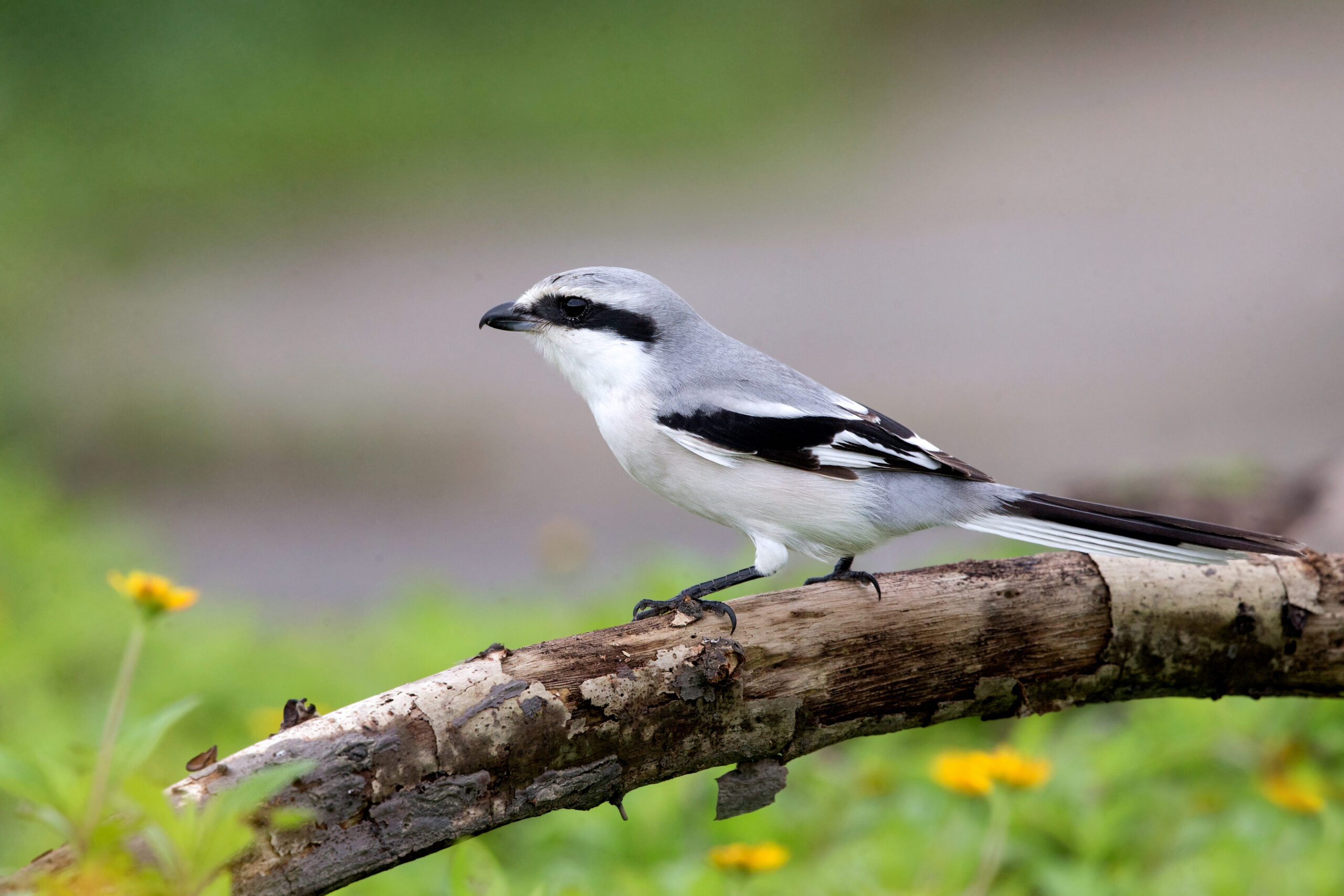
Note the distinctive white “slash” in the wing of this Chinese Gray Shrike © David Irving / Macaulay Library
Dunn’s Lark Eremalauda dunni is split into:
- Dunn’s Lark Eremalauda dunni [map] [media] [my records]
- Arabian Lark Eremalauda eremodites [map] [media] [my records]
Although these two do not normally overlap, vagrants can be tricky to assign to species. Note that a well-photographed Cyprus record is believed to be Dunn’s Lark from Africa, so long distance vagrancy is possible in this species pair.
Lesser Short-toed Lark Alaudala rufescens is split into:
- Mediterranean Short-toed Lark Alaudala rufescens [map] [media] [my records]
- Turkestan Short-toed Lark Alaudala heinei [map] [media] [my records]
The two new species are very tough to identify visually (vocalizations will help) but usually segregate by range, though both may be represented among vagrant records in western and northern Europe.
Brown Prinia Prinia polychroa and Striated Prinia Prinia crinigera are reassessed and subdivided into five species, as follows:
- Himalayan Prinia Prinia crinigera [map] [media] [my records]
- Striped Prinia Prinia striata [map] [media] [my records]
- Burmese Prinia Prinia cooki [map] [media] [my records]
- Annam Prinia Prinia rocki [map] [media] [my records]
- Brown Prinia Prinia polychroa [map] [media] [my records]
Burmese Prinia is a Myanmar endemic while Annam Prinia is restricted to the Langbian Plateau, a region of high endemism in Vietnam. Striated Prinia is split into Himalayan Prinia, in the western ortion of the species’s former range from Pakistan to sw. China, while Striped Prinia occurs in the remainder of China and Taiwan. After these changes, and a shift of one subspecies to Striped Prinia, the range of Brown Prinia is now restricted to Laos, Thailand, and Cambodia, with another population in Java.
Graceful Prinia Prinia gracilis is split into:
- Graceful Prinia Prinia gracilis [map] [media] [my records]
- Delicate Prinia Prinia lepida [map] [media] [my records]
These similar-looking species do have consistent differences in vocalizations and genetics. Delicate Prinia is the more northerly species, occurring from Turkey east to India, through northern Saudi Arabia, Bahrain, UAE, and northern Oman and east to Pakistan, India, and Nepal. Graceful Prinia is now restricted to north Africa and much of the remainder of the Arabian peninsula (including southern Oman).
Chestnut-backed Bush Warbler Locustella castanea is split into:
- Sulawesi Bush Warbler Locustella castanea [map] [media] [my records]
- Seram Bush Warbler Locustella musculus [map] [media] [my records]
- Buru Bush Warbler Locustella disturbans [map] [media] [my records]
Seram and Buru continue their track record for endemism, as their versions of Chestnut-backed Bush Warbler are each recognized as yet another single island endemic, precipitating a name change to Sulawesi Bush Warbler for the remainder of the population which itself is restricted to the larger island of Sulawesi.
Little Rush-Warbler Bradypterus baboecala is split into:
- Little Rush Warbler Bradypterus baboecala [map] [media] [my records]
- Highland Rush Warbler Bradypterus centralis [map] [media] [my records]
Generally restricted to higher elevation swamps in central Africa, Highland Rush Warbler is split from the more widespread Little Rush Warbler, which occurs from swamps of west Africa (where recently discovered and maybe of an unknown subspecies) to Ethiopia and south to South Africa.
Gray-cheeked Bulbul Alophoixus bres is split into:
- Gray-cheeked Bulbul Alophoixus tephrogenys [map] [media] [my records]
- Brown-cheeked Bulbul Alophoixus bres [map] [media] [my records]
Brown-cheeked Bulbul is endemic to Java and Bali. Gray-cheeked Bulbul occurs on Sumatra, the mainland from Myanmar to the Malaysia Peninsula, and Borneo.
Ochraceous Bulbul Alophoixus ochraceus is split into:
- Penan Bulbul Alophoixus ruficrissus [map] [media] [my records]
- Ochraceous Bulbul Alophoixus ochraceus [map] [media] [my records]
Penan Bulbul of Borneo is split from Ochraceous Bulbul which occurs throughout the remainder of the range in SE Asia.
Island Leaf Warbler Phylloscopus maforensis is split into:
- Island Leaf Warbler Phylloscopus poliocephalus [map] [media] [my records]
- Numfor Leaf Warbler Phylloscopus maforensis [map] [media] [my records]
- Biak Leaf Warbler Phylloscopus misoriensis [map] [media] [my records]
Two new island endemics off New Guinea; note that Numfor Leaf Warbler takes the species epithet maforensis, so the scientific name of Island Leaf Warbler changes.
Subalpine Warbler Sylvia cantillans is split into:
- Western Subalpine Warbler Curruca iberiae [map] [media] [my records]
- Eastern Subalpine Warbler Curruca cantillans [map] [media] [my records]
This is the second round of recent splits in this complex, following the recently recognition of Moltoni’s Warbler Sylvia subalpina. These two species differ subtly: watch for differences in the breadth of the malar area, back color, and the color of the underparts between Eastern Subalpine Warbler and Western Subalpine Warbler. In some plumages, they may not be identifiable. The subspecies inornata is now synonymized with iberiae as well, so observers familiar with that subspecies should be aware that it is now the same as Western Subalpine Warbler.
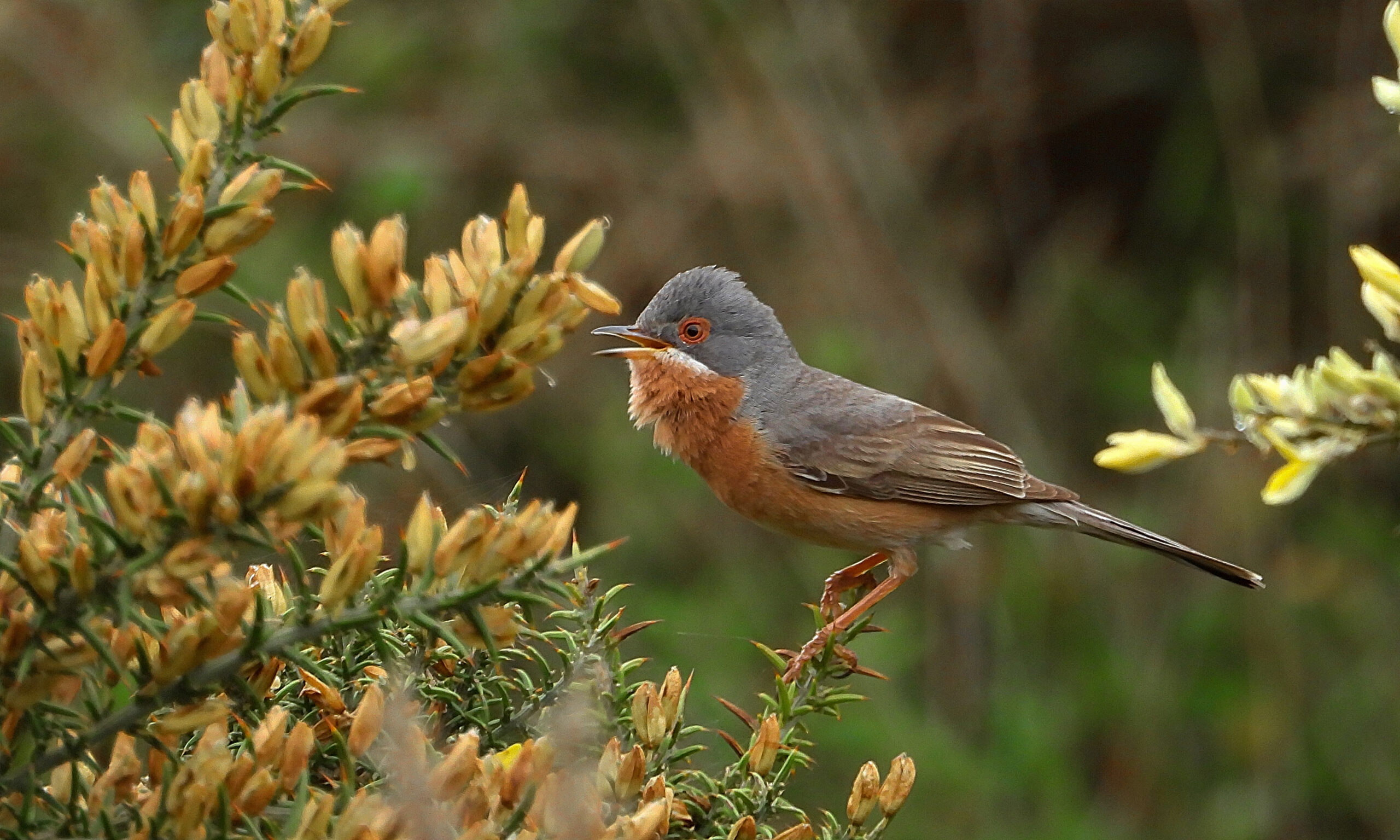
The brownish wash on the back, narrow white malar mark, and rich, extensive reddish coloration on the underparts of this Western Subalpine Warbler distinguishes it from the recently split Eastern Subalpine Warbler. Western Subalpine Warbler © Rui Jorge / Macaulay Library
Abyssinian White-eye Zosterops abyssinicus is split into:
- Abyssinian White-eye Zosterops abyssinicus [map] [media] [my records]
- Socotra White-eye Zosterops socotranus [map] [media] [my records]
Socotra White-eye is nearly endemic to Socotra, but may also be found in mainland Africa in north Somalia.
African Yellow White-eye Zosterops senegalensis is split into:
- Forest White-eye Zosterops stenocricotus [map] [media] [my records]
- Green White-eye Zosterops stuhlmanni [map] [media] [my records]
- Northern Yellow White-eye Zosterops senegalensis [map] [media] [my records]
- Southern Yellow White-eye Zosterops anderssoni [map] [media] [my records]
White-eyes continue to be more and more recognized for their impressive levels of speciation, with four secies recognized within African Yellow White-eye, following a big slate of Zosterops splits in 2019. Watch for Forest White-eye in wetter forests of se. Nigeria, Bioko, Cameroon and Gabon, for Green White-eye in lowland areas near Lake Victoria, Northern Yellow White-eye widely from Senegal to Kenya, and Southern Yellow White-eye from Tanzania southwards.
Lemon-bellied White-eye Zosterops chloris is split into:
- Lemon-bellied White-eye Zosterops chloris [map] [media] [my records]
- Wakatobi White-eye Zosterops flavissimus [map] [media] [my records]
Wakatobi is an archipelago of over 150 islands south of Sulawesi which hosts this new endemic, split from the more widespread Lemon-bellied White-eye.
Solomons White-eye Zosterops kulambangrae is split into:
- Solomons White-eye Zosterops kulambangrae [map] [media] [my records]
- Dark-eyed White-eye Zosterops tetiparius [map] [media] [my records]
The oxymoronic Dark-eyed White-eye, of Rendova and Tetipare islands, is split from Solomons White-eye, which is more widespread in the archipelago. Both species have brownish irides, but differ in the presence of a broken white eye ring, which Solomons White-eye has and which most Zosterops have (hence the name, “white-eye”); the white eye ring is lacking in Dark-eyed White-eye.
Limestone Wren-Babbler Turdinus crispifrons is split into:
- Annam Limestone Babbler Gypsophila annamensis [map] [media] [my records]
- Rufous Limestone Babbler Gypsophila calcicola [map] [media] [my records]
- Variable Limestone Babbler Gypsophila crispifrons [map] [media] [my records]
As with many splits in 2021, it was a careful analysis of genetics in combination with vocalizations that has redefined the species limits in Limestone Wren-Babbler (and precipitated a change to the use of Limestone Babbler for this genus, which has itself is new in this update). This species is actually more different in plumage within one species–Variable Limestone Babbler, which can have white or gray underparts–than it is between species, so using plumage to define the species here might have been misleading.
Brown-headed Nuthatch Sitta pusilla is split into:
- Brown-headed Nuthatch Sitta pusilla [map] [media] [my records]
- Bahama Nuthatch Sitta insularis [map] [media] [my records]
New research documenting vocal differences between mainland and Bahama birds suggest that they are two different species. The Bahama Nuthatch faces an uncertain future—as recently as 2018 only a few individuals remained. The pine forests on Grand Bahama where the Bahama Nuthatch resides continue to be battered by severe hurricanes. The most recent hurricane in September 2019 (Hurricane Dorian) destroyed much of the remaining habitat. Extensive searching following Hurricane Dorian failed to turn up a single Bahama Nuthatch, leaving some to fear that the species may be extinct.
Tropical Gnatcatcher Polioptila plumbea is split into:
- Tropical Gnatcatcher Polioptila plumbea [map] [media] [my records]
- White-browed Gnatcatcher Polioptila bilineata [map] [media] [my records]
This split recognizes the distinctive plumage, vocalizations, and genetics of the White-browed Gnatcatcher that occurs in Middle America and the drier habitats west of the Andes.
Sedge Wren Cistothorus platensis is split into:
- Sedge Wren Cistothorus stellaris [map] [media] [my records]
- Grass Wren Cistothorus platensis [map] [media] [my records]
This split recognizes the distinctive song, plumage, and migratory behavior of each species. The migratory Sedge Wren breeds in central-northern North America and winters in the southern US; it sings a fairly uniform song, while the non-migratory Grass Wren occurs from Mexico to South America and sings a more complex song. The two species co-occur only in Mexico in the northeastern state of Veracruz (though at opposite ends of the state, not at a single site).
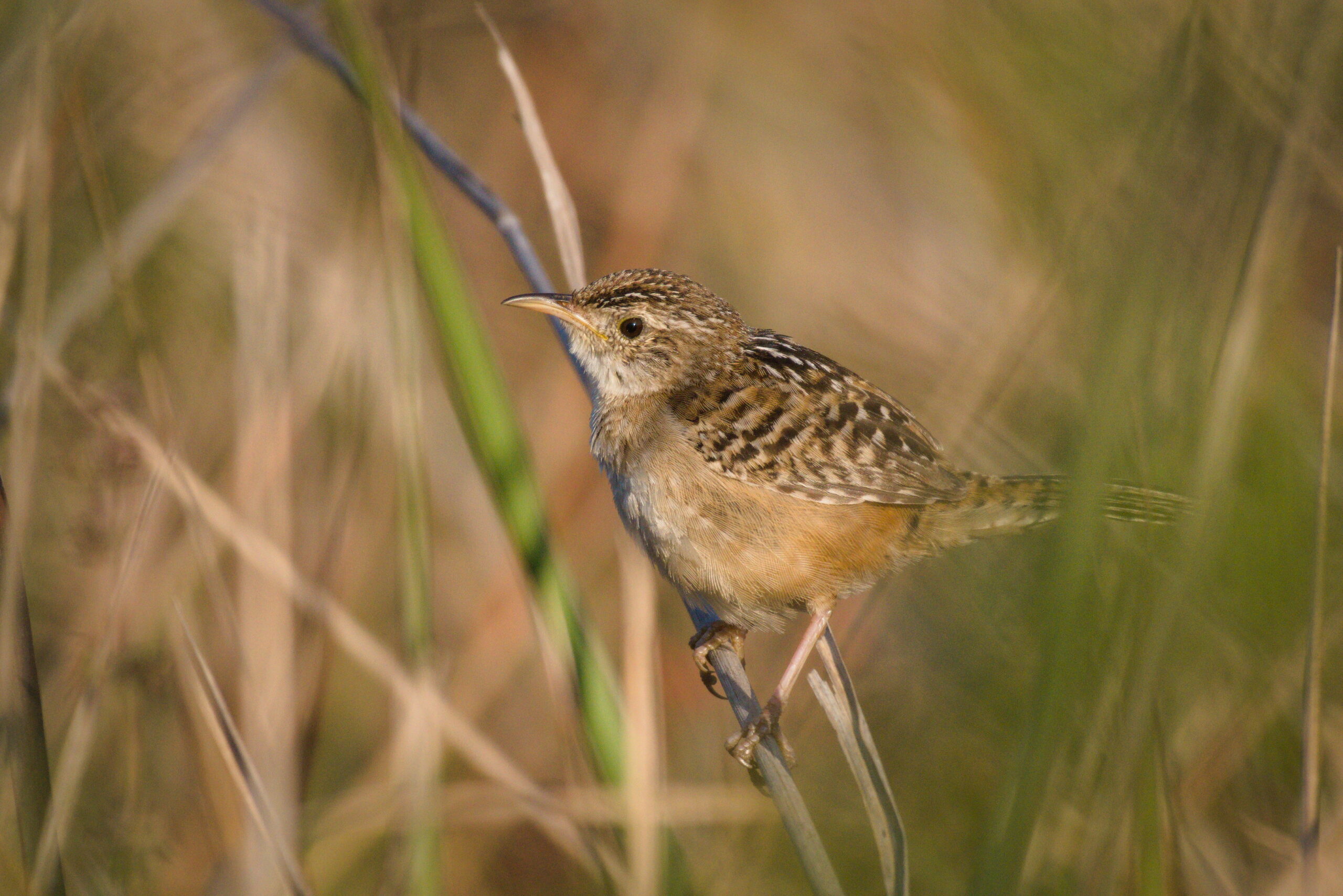
Grass Wren © José Alberto Lobato García / Macaulay Library
Spotted Nightingale-Thrush Catharus dryas is split into:
- Yellow-throated Nightingale-Thrush Catharus dryas [map] [media] [my records]
- Speckled Nightingale-Thrush Catharus maculatus [map] [media] [my records]
These two species are very similar in plumage but are widely disjunct in range, with Yellow-throated Nightingale-Thrush occurring in Middle America and Speckled in the Andes of South America.
Hill Blue Flycatcher Cyornis banyumas is split into:
- Hill Blue Flycatcher Cyornis whitei [map] [media] [my records]
- Javan Blue Flycatcher Cyornis banyumas [map] [media] [my records]
- Dayak Blue Flycatcher Cyornis montanus [map] [media] [my records]
With this split, Javan Blue Flycatcher becomes a critically endangered species given its rare and declining population on Java, which (like many species) is suffering from illegal bird trapping in the region; it is considered a Sensitive Species in eBird due to this threat.
Narcissus Flycatcher Ficedula narcissina is split into:
- Narcissus Flycatcher Ficedula narcissina [map] [media] [my records]
- Ryukyu Flycatcher Ficedula owstoni [map] [media] [my records]
Endemic to a few islands in the Ryukyu island chain of Japan, Ryukyu Flycatcher, which appeared in eBird previously as Narcissus Flycatcher (Green-crowned), can be identified in its male plumage by its greenish upperparts, including the back and crown. Although it is largely resident, it has strayed north, south, and west of its home islands and it is also important to identify your Ficedula with care because both Narcissus Flycatcher and Ryukyu Flycatcher may occur on the same islands in migration.
Siberian Stonechat Saxicola maurus is split into:
- Siberian Stonechat Saxicola maurus [map] [media] [my records]
- Amur Stonechat Saxicola stejnegeri [map] [media] [my records]
Amur Stonechat, sometimes also known as Stejneger’s Stonechat, breeds in northeast Asia and winters broadly in Southeast Asia. It can be very challenging to separate from some taxa of Siberian Stonechat, especially since both species are prone to long-distance vagrancy.
Black-eared Wheatear Oenanthe hispanica is split into:
- Western Black-eared Wheatear Oenanthe hispanica [map] [media] [my records]
- Eastern Black-eared Wheatear Oenanthe melanoleuca [map] [media] [my records]
Although these species are largely separated by range, wheatears can be challenging to identify both on their breeding and winter ranges and these two species may come in contact or overlap slightly. Moreover, both occur as strays outside their core range. Use caution when ID is uncertain.
Streak-headed Munia Lonchura tristissima is split into:
- Streak-headed Munia Mayrimunia tristissima [map] [media] [my records]
- White-spotted Munia Mayrimunia leucosticta [map] [media] [my records]
Fairly distinctive in plumage, these two populations on New Guinea are hereby recognized as distinct species.
Long-billed Pipit Anthus similis is split into:
- Long-billed Pipit Anthus similis [map] [media] [my records]
- Nicholson’s Pipit Anthus nicholsoni [map] [media] [my records]
Nicholson’s Pipit occupies the southern third of Africa while the Long-billed Pipit occurs from Kenya north through the Middle East and east to India. Throughout the range of the Long-billed Pipit many distinctive forms exist, hence there may be additional splits in the future as more data becomes available.
Scrub Euphonia Euphonia affinis is split into:
- West Mexican Euphonia Euphonia godmani [map] [media] [my records]
- Scrub Euphonia Euphonia affinis [map] [media] [my records]
West Mexican Euphonia differs in genetics, subtly in some vocalizations, and in its white (vs. yellow) undertail coverts. It adds an endemic species to Mexico.
Gray-headed Bullfinch Pyrrhula erythaca is split into:
- Gray-headed Bullfinch Pyrrhula erythaca [map] [media] [my records]
- Taiwan Bullfinch Pyrrhula owstoni [map] [media] [my records]
Taiwan gains yet another endemic; Gray-headed Bullfinch is now restricted to the eastern Himalaya.
Stripe-capped Sparrow Rhynchospiza strigiceps is split into:
- Yungas Sparrow Rhynchospiza dabbenei [map] [media] [my records]
- Chaco Sparrow Rhynchospiza strigiceps [map] [media] [my records]
There are differences in face pattern (more black around the face and a broader malar in Yungas Sparrow) but the species remain very similar. Fortunately, they have different habitats and regions of occurrence.
Saffron-billed Sparrow Arremon dorbignii is split into:
- Moss-backed Sparrow Arremon dorbignii [map] [media] [my records]
- Saffron-billed Sparrow Arremon flavirostris [map] [media] [my records]
Moss-backed Sparrow occurs on the east slope of the Andes from Bolivia to northern Argentina, has a different voice, greenish back, and fairly narrow breastband; it is unlikely to overlap with the similar Saffron-billed Sparrow, which may have a grayish or greenish back, is somewhat migratory, and occurs in the Chaco, Cerrado, or Atlantic Forest habitats of southeast Brazil, northern Argentina, Paraguay, and extreme southeast Bolivia.
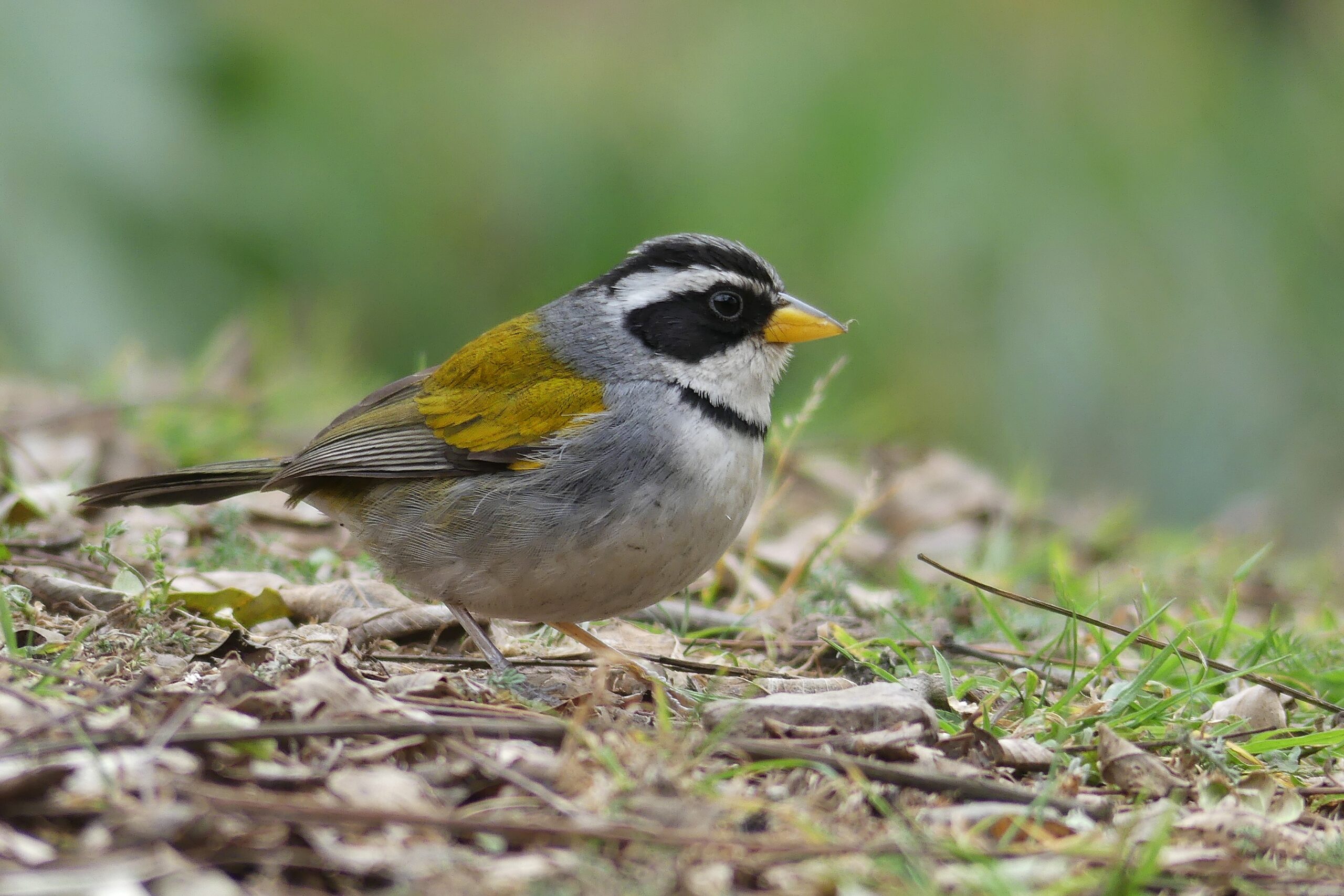
Moss-backed Sparrow © Jorge Quiroga / Macaulay Library
Rufous-capped Warbler Basileuterus rufifrons is split into:
- Rufous-capped Warbler Basileuterus rufifrons [map] [media] [my records]
- Chestnut-capped Warbler Basileuterus delattrii [map] [media] [my records]
Although the two may co-occur at some of the same sites in Guatemala, Chestnut-capped predominantly occurs on the Pacific slope of Chiapas and Guatemala, and in from central Guatemala south to South America. Rufous-capped is the only species in Belize and much of Mexico (with vagrants and occasional breeding pairs in the southwest US). In addition to different songs, Chestnut-capped has more chestnut in the ear coverts and also has distinctive yellow throughout the underparts, while Rufous-capped has a whitish or grayish belly in all subspecies (salvini has somewhat more extensive yellow).
Puerto Rican Bullfinch Melopyrrha portoricensis is split into:
- Puerto Rican Bullfinch Melopyrrha portoricensis [map] [media] [my records]
- St. Kitts Bullfinch Melopyrrha grandis [map] [media] [my records]
St. Kitts Bullfinch is substantially larger and has other plumage differences that merit recognition as a separate species. The only endemic species for St. Kitts, the St. Kitts Bullfinch is unfortunately believed extinct (last recorded in the 1920s) and was only ever known from the highest mountain peaks of St. Kitts—an area where few people visit. This is a bird worth searching for!
Grayish Saltator Saltator coerulescens is split into:
- Olivaceous Saltator Saltator olivascens [map] [media] [my records]
- Cinnamon-bellied Saltator Saltator grandis [map] [media] [my records]
- Blue-gray Saltator Saltator coerulescens [map] [media] [my records]
Grayish Saltator was one of the more widespread passerines in the Neotropics, occurring from northern Mexico to Argentina. New research examining genetic, vocal, and plumage differences demonstrate that the Grayish Slatator is composed of three species: Cinnamon-bellied Saltator, occurring from northern Mexico to western Costa Rica; Olivaceous Saltator, occurring from northern Colombia to Venezuela, Trinidad, the Guianas, and adjacent northern Brazil; and Blue-gray Saltator occurring across most of Amazonia, from eastern Colombia, to Bolivia and northern Argentina, including much of Brazil
2021 ‘Lumps’
Vaurie’s Nightjar Caprimulgus centralasicus, known only from a single specimen from Xinjiang, China, is now thought to be an unusual plumage of juvenile Eurasian Nightjar Caprimulgus europaeus [map] [media] [my records]
Chapman’s Swift Chaetura chapmani and Amazonian Swift Chaetura viridipennis are now believed to represent two subspecies within Chapman’s Swift Chaetura chapmani [map] [media] [my records]
These two taxa were formerly separable only by range and subtle measurements. The range of Chapman’s Swift expands considerably to include central and southern Amazonia, south to northern Argentina.
Schouteden’s Swift Schoutedenapus schoutedeni type specimens were demonstrated to pertain to Scarce Swift Schoutedenapus myoptilus [map] [media] [my records]
Tawny Piculet Picumnus fulvescens is lumped with Ochraceous Piculet Picumnus limae [map] [media] [my records]
These forms differ primarily in their underparts coloration (whitish in Ochraceous and tawny, unsurprisingly, in Tawny). However, their calls do not differ, both types occur together and seem to interbreed, and fulvescens is better considered a synonym of limae. The Tawny Piculet is no longer recognized even as a subspecies.
Crested Caracara Caracara cheriway and Southern Caracara Caracara plancus are once again lumped as Crested Caracara Caracara plancus [map] [media] [my records]
In 2000, the Crested Caracara Caracara plancus was split based on differences in plumage characteristics. But new evidence suggests that split was premature. Physical differences between the two taxa are fairly subtle (more white barring on the back for Southern Caracara) and—as both expand their ranges in South American due to deforestation—they interbreed freely where the ranges overlap, suggesting that full species status is not warranted.

Farewell, Southern Caracara. Crested Caracara (Southern) © Luciano Massa / Macaulay Library
Rondonia Woodcreeper Lepidocolaptes fuscicapillus fuscicapillus and Layard’s Woodcreeper Lepidocolaptes layardi show minimal plumage and vocal differences and are are hereby lumped as Dusky-capped Woodcreeper Lepidocolaptes fuscicapillus [map] [media] [my records]
In Australia, Pilbara Grasswren Amytornis whitei and Sandhill Grasswren Amytornis whitei oweni are lumped as Rufous Grasswren Amytornis whitei [map] [media] [my records]
Northwestern Crow Corvus caurinus is lumped with American Crow Corvus brachyrhynchos [map] [media] [my records].
Restricted to the Pacific Northwest of the United States, the Pacific Coast of Canada, and southeastern Alaska, Northwestern Crow has always been a controversial entity, especially at the southern margins of its range where it is believed to hybridize extensively with American Crow. New genetic data highlight the extent of that hybridization, suggesting that Northwestern Crow does not warrant species status and should be lumped with the widespread American Crow.

